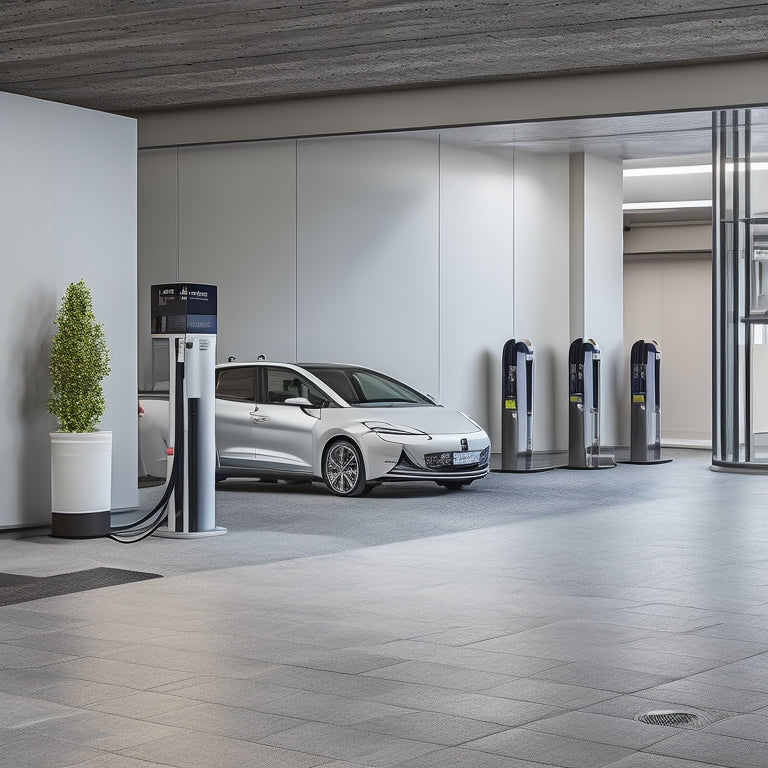
Installing EV Chargers in Apartment Buildings: A Guide
Share
You're considering installing EV chargers in your apartment building, a timely move given the projected global EV market growth to $802.4 billion by 2027. By doing so, you'll attract tenants who value convenience, increase satisfaction and loyalty, and reduce turnover rates. To get started, assess your building's electrical infrastructure, consider the number of potential EV owners among tenants, and gauge interest through surveys. Next, choose the right charger type, considering power requirements and installation costs. Remember to account for installation and maintenance costs, and collaborate with licensed electricians. As you steer through the process, stay tuned for more perspectives on overcoming common implementation challenges and maximizing the benefits of EV charging infrastructure in your apartment building.
Key Takeaways
- Assess the apartment building's electrical infrastructure to determine its readiness for EV charging installation.
- Choose the right EV charger type (Level 1, Level 2, or DC Fast Charging) based on tenants' needs and parking spaces.
- Collaborate with licensed electricians to ensure optimal installation, and develop a maintenance schedule for efficient operation.
- Research and navigate local regulations, permits, and incentives to overcome implementation challenges and reduce costs.
- Educate tenants on the benefits and proper use of EV chargers to promote adoption and maximize ROI.
Benefits of EV Charging Infrastructure
With the increasing adoption of electric vehicles (EVs), installing EV charging infrastructure in apartment buildings has become an essential consideration.
You'll reap several benefits by doing so. To begin with, you'll attract tenants who value the convenience of EV charging, leading to increased tenant satisfaction and loyalty. This, in turn, can result in cost savings through reduced turnover rates and improved property value.
In addition, offering EV charging infrastructure demonstrates your commitment to reducing your building's environmental impact, appealing to environmentally conscious tenants. By integrating solar power into your EV charging stations, you can further enhance grid resilience and reduce your carbon footprint.
Furthermore, this integration can lead to lower operating costs and predictable energy expenses, making it a financially savvy decision.
Assessing Apartment Building Readiness
Before installing EV chargers, you need to evaluate your apartment building's readiness for this new technology.
Examine your building's electrical infrastructure to determine its load capacity. Can it support the increased power demands of EV charging? You'll need to take into account factors like the age and condition of your electrical system, as well as the number of potential EV owners among your tenants.
With the global electric vehicle market projected to reach $802.4 billion by 2027 market growth, it's important to plan for the increased demand.
Evaluating tenant interest is also vital. Conduct a survey to gauge demand and identify potential users. This will help you determine the number and type of chargers needed.
Choosing the Right EV Charger
Your apartment building is now prepared for EV charger installation, and it's time to select the right charger for your tenants' needs.
You'll need to evaluate the charger types and power requirements to guarantee you're providing a convenient and efficient charging experience. There are three main types of EV chargers: Level 1, Level 2, and DC Fast Charging. Level 1 uses a standard 120-volt outlet, while Level 2 uses a 240-volt outlet, providing faster charging.
Installation costs for commercial EV charging stations range from $500 to $50,000+, and solar-powered systems can lead to significant energy savings.
DC Fast Charging is the fastest option, but it requires a high-power connection. Determine the power requirements based on the number of tenants, parking spaces, and charging speeds needed.
Installation and Maintenance Considerations
Now that you've selected the right EV charger for your apartment building, it's time to contemplate the installation and maintenance requirements.
Consider the installation costs, including materials, labor, and any necessary electrical upgrades to support the charger, as infrastructure changes can greatly influence installation costs.
It's also crucial to collaborate with licensed electricians to guarantee ideal location selection and power evaluation.
Develop a maintenance schedule to make certain the charger operates efficiently and safely. Regularly inspect and clean the charger, and perform software updates as needed.
Engage with your tenants to educate them on proper charger use and maintenance. This will help prevent issues and minimize downtime.
Additionally, establish a process for reporting and addressing any technical issues or concerns.
Overcoming Common Implementation Challenges
Several obstacles can hinder the successful implementation of EV charging stations in apartment buildings, and being aware of these potential challenges is fundamental to overcoming them.
You'll likely face regulatory barriers, such as obtaining necessary permits and complying with local building codes. To overcome these, research local regulations and engage with authorities early on.
Additionally, taking advantage of federal and state incentives can help alleviate the financial burden of installation. Moreover, utility-based incentives, such as special rates and discounts, can also be utilized to promote electric vehicle adoption.
Tenant engagement is also imperative, as you'll need to educate residents on charger usage and benefits. Effective cost management is essential, too, as you'll need to balance charger installation and maintenance expenses with revenue from charging fees.
Finally, utility collaboration is key, as you'll need to work with your utility provider to guarantee sufficient electrical capacity and negotiate favorable rates.
Frequently Asked Questions
Can Apartment Buildings Claim Federal Tax Credits for EV Charger Installations?
You can claim federal tax credits for EV charger installations, which can considerably offset installation costs, and take advantage of federal incentives, providing a financial enhancement to your eco-friendly investment.
How Do I Handle EV Charger Liability Insurance for My Apartment Building?
You're fundamentally playing with fire if you don't secure liability insurance for your EV chargers - a single lawsuit could bankrupt your building! Research top insurance providers to find extensive liability coverage that shields you from financial disaster.
Are There Any EV Charger Noise Level Regulations I Need to Comply With?
You'll need to evaluate charger sound levels, ensuring they don't exceed 70 dBA. Implement noise mitigation strategies, like installing chargers away from living spaces or using sound-absorbing materials, to comply with regulations and maintain a peaceful environment.
Can I Restrict EV Charger Use to Certain Residents or Guests?
Like a gatekeeper controlling access to a exclusive club, you can restrict EV charger use to certain residents or guests by implementing access control systems and outlining clear resident agreements, ensuring a fair and organized charging experience.
How Do I Monitor and Report EV Charger Energy Usage for Billing Purposes?
You'll need an energy monitoring system to track charger usage, then generate usage reports for billing purposes; consider integrating a smart charging platform that provides real-time data and automated reporting to simplify the process.
Related Posts
-

How to Upgrade Your Home With Geothermal Innovations
You're now on the cusp of utilizing the Earth's natural thermal energy to revolutionize your home's heating and cooli...
-

Why Merge Earth's Heat With Sun's Energy?
You're about to utilize the full potential of renewable energy by combining the Earth's natural heat with the Sun's a...
-

7 Solar-Safe Window Solutions for Earth-Conscious Homeowners
As an earth-conscious homeowner, you're likely keen to find solar-safe window solutions that align with your values. ...


